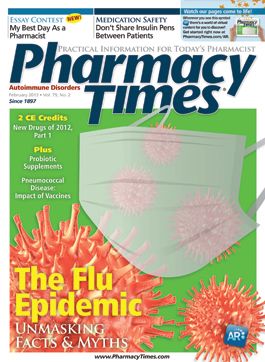Publication
Article
Pharmacy Times
Case Studies in Self-Care


Case 1—Jock Itch
BP is a 31-year-old obese man who reports experiencing red, itchy, scaling lesions between the upper thigh and groin area of both of his legs for the past few days. He has been going to the gym since the New Year as part of a resolution to improve his health. BP has never experienced a rash like this before and reports noticing its onset since he began to increase his level of physical activity. He says he has no allergies to medication and reports having a history of dyslipidemia, for which he has been prescribed atorvastatin 20 mg daily. His doctor indicated that he has borderline high blood pressure, and he says his new physical fitness routine is an effort to help control his blood pressure without medication. Is BP a candidate for self-care? What OTC products would you recommend to treat his rash?
Answer
BP’s symptoms coupled with his recent increase in physical activity level are consistent with jock itch, or tinea cruris, a localized skin infection caused by a fungus that usually thrives in warm, damp environments.1 Jock itch can occur in any area of the body that is subject to friction and moisture.
BP is a candidate for self-treatment with a nonprescription antifungal agent as he has neither a history of diabetes, immune deficiency, other systemic illness, nor signs of a secondary bacterial infection that would warrant referral to a physician for evaluation.1
Nonprescription antifungals typically used to treat jock itch include clotrimazole 1%, miconazole nitrate 2%, butenafine 1%, terbinafine HCl 1%, and tolnaftate 1%. BP can be instructed to follow the directions on the product labeling and to apply the selected agent once or twice daily (depending on the product and dosage form) for up to 2 weeks. It is also important to educate BP on the importance of good personal hygiene and of keeping the area dry and free from moisture to prevent reinfection and promote resolution.
Case 2—Urinary Tract Infection
CD is a 22-year-old female college student who comes to the student health center to enquire about a product she recently saw in a magazine advertisement. She reports having just completed a 3-day course of antibiotics for a urinary tract infection but says she is still experiencing some residual burning when she urinates. She remembers seeing an advertisement for a home urinary tract infection screening test and she would like to know more about how this type of product works. She has no allergies to medications and says she has no chronic medical conditions. Is CD a candidate for using a home urinary tract infection screening kit at this time? If so, how would you instruct her on the use of this type of product?
Answer
Among currently available home urinary tract infection test kits, those that detect both nitrite and leukocyte esterase are more sensitive and specific and have a lower incidence of false negative results than those that detect nitrite alone.2 If CD planned to use the kit to see whether she had an infection in the first place, then referral to a physician for treatment would be warranted. Because she plans to use the kit to confirm the eradication of a urinary infection after a course of antibiotic therapy, she is a candidate for using a home screening kit.
Be sure to inform CD that the test results may come back as falsely positive if she is using phenazopyridine, taking high doses of vitamin C, or menstruating while collecting and testing the urine sample.2 Instruct her to clean the genital area thoroughly prior to use to avoid contamination of the urine sample and recommend that she test her first morning urine for 3 consecutive days to increase the accuracy of her test results. If she continues to experience persistent symptoms despite obtaining a negative test or if her test comes back as positive, she should follow up with her primary care provider.
Case 3—Earache
AG is a 54-year-old woman who approaches the pharmacist seeking relief from an earache. She says she recently returned home from vacation at a beach resort and has been experiencing a sensation of fullness in her right ear that has become increasingly bothersome over the past few days. She reports experiencing diminished hearing in that ear accompanied by congestion that she attributes to having gotten water in her ears in the pool. Otherwise, she says she has had no fever, severe pain, discharge, or wax accumulation. AG has a previous diagnosis of hypertension and thyroid disease, which she manages with lisinopril 20 mg daily and levothyroxine 75 mcg daily. She says she has no allergies to medications. AG would like to know if she can alleviate the fullness in her ear without a prescription medication and if you have any additional recommendations to help resolve her symptoms.
Answer
AG’s symptoms are consistent with water-clogged ears, especially given that her symptoms began after she spent time in the pool. It would be prudent to ask her about any recent ear surgery or history of ear or tympanic membrane trauma; the presence of these factors would preclude self-treatment. upon establishing that AG is a candidate for self-treatment, recommending both nonpharmacologic and pharmacologic interventions to relieve her ear fullness would be warranted.
Recommend that AG tilt her head from side to side to try to expel any residual water that might remain in the ear canal and suggest that she use a blowdryer set on low and pointed across (not into) the ear canal after swimming to dry excess water. The only OTC agent approved for drying water-clogged ears is isopropyl alcohol 95% in anhydrous glycerin 5%. Recommend that AG instill 5 to 10 drops into the affected ears for several days until symptoms resolve; if she does not experience relief within 5 days, recommend that she follow up with her primary care provider for further evaluation.3
Case 4—Pinworm Infection
BK is a 12-year-old boy whose mother approaches the pharmacy counter seeking a recommendation for a treatment for her son’s anal itching. The mother explains that BK’s 3-year-old brother and 7-year-old sister were recently diagnosed with and treated for pinworms by their pediatrician. She recalls that the doctor instructed her that she should seek OTC treatment if anyone else in the household experienced similar symptoms. However, she is unsure where to find an appropriate product on the pharmacy shelves. She says that BK has no allergies or chronic illnesses and takes no other medications. Is BK a candidate for self-care? What interventions would you recommend for BK’s symptoms?
Answer
BK is likely suffering from pinworms, often caused by ingestion of eggs from others who are host to them, and it is very likely that they were spread from one of his siblings. Pinworms are the most common type of worm infestation in the United States and the only type of intestinal worm infection that can be treated with self-care and OTC antihelminthic therapy.4 All OTC products indicated for the treatment of pinworm infections contain pyrantel; it would be prudent to ask BK’s mother whether BK has ever taken pyrantel before and, if so, whether he has experienced any type of hypersensitivity to this agent.
Side effects of pyrantel are generally transient and may include nausea, vomiting, and diarrhea.4 Pyrantel is available in a variety of dosage forms, including chewable tablets, liquid, and capsule forms, and dosing is weight-based at 11 mg/kg (1 g maximum) as a single dose. In addition, recommend that BK’s mother consider decontaminating the household (eg, washing all bed linens and bath towels in hot water, disinfecting the toilet and bathroom areas of the home) to reduce the risk of spread to others in the household and to minimize the risk of reinfection. If BK’s symptoms do not resolve after 2 weeks, physician follow-up is recommended.
Dr. Mansukhani is a clinical pharmacist in South Plainfield, New Jersey, and clinical assistant professor, Ernest Mario School of Pharmacy, Rutgers University. Dr. Bridgeman is an internal medicine clinical pharmacist in Trenton, New Jersey, and clinical assistant professor, Ernest Mario School of Pharmacy, Rutgers University
References
- Newton GD, Popovich NG. Fungal skin infections. In: Krinsky DL, Berardi RR, Ferreri SP, et al (eds). Handbook of Nonprescription Drugs: An Interactive Approach to Self-Care. 17th ed. Washington, DC: American Pharmacists Association; 2011:757-771.
- Briggs GC, Hurley H. Home testing and monitoring devices. In: Krinsky DL, Berardi RR, Ferreri SP, et al (eds). Handbook of Nonprescription Drugs: An Interactive Approach to Self-Care. 17th ed. Washington, DC: American Pharmacists Association; 2011:925-927.
- Krypel L. Otic disorders. In: Krinsky DL, Berardi RR, Ferreri SP, et al (eds). Handbook of Nonprescription Drugs: An Interactive Approach to Self-Care. 17th ed. Washington, DC: American Pharmacists Association; 2011:561-569.
- Goad JA, Mirzaian E. Pinworm infection. In: Krinsky DL, Berardi RR, Ferreri SP, et al (eds). Handbook of Nonprescription Drugs: An Interactive Approach to Self-Care. 17th ed. Washington, DC: American Pharmacists Association; 2011:313-321.







